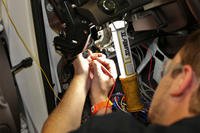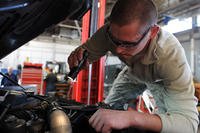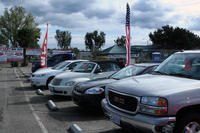by Ben Higgins
Jump Links
- The Inception Of The International Scout
- The Scout 800
- The International Scout II
- The Scout's Legacy And Revival
- Rivals Of The Time Reinvigorated
The International Scout was and remains an icon of post-war America, rivaling Jeep as the earliest lifestyle vehicle brand that was meant to go anywhere, carry anything, and do it while being painted wacky bright colors. So how did the old Scout truck come to be, how did a tractor-maker create an icon, and what has become of the International Harvester Scout, and the subsequent Scout brand since its inception? In this article, we look back on the International Scout and see what lies ahead.
The Inception Of The International Scout
An Unusual Beginning

Bring A Trailer
International Harvester was founded on March 22, 1902. It would spend most of the early 20th century building tractors, farming equipment, and, more importantly for us car enthusiasts, light- and medium-duty pickups. International was relegated to the commercial class of vehicles, not producing a passenger-oriented model till the International Travelall, a Chevrolet Suburban rival that pre-dated the International Scout by over 10 years. International continued to dip into the consumer market with the introduction of the International Scout.
During this post-war period, the Jeep CJ was quickly becoming a popular hit for farmers and adventurers, with International taking note of this trend and deciding to step into the market. It initially went up against the Jeep CJ, but the Scout eventually also competed with the Ford Bronco, Dodge Ramcharger, and Cheverolt Blazer.
In a famous quote from the Scout's chief designer, Ted Ornas, the International Scout concept came from the mission brief of "design something to replace the horse." And that is exactly what International tried to do with the original Scout - it was bare-bones and simple. The Scout 80 was the first in the Scout lineage. It was initially a two-door pick-up but would expand to become an SUV, with a fold-down windshield, vacuum windshield wipers, a removable roof and windows, and not much else. It was a rather utilitarian vehicle powered by a gas 152 (2.5L) inline-four hooked up to a three-speed manual.
It was a successful model for International, with a celebratory model made to commemorate the 100,000th Scout being built. The Scout "Red Carpet" featured a full-length headliner, full floor mats, red interior trim and a white exterior paint job.
The Scout 800
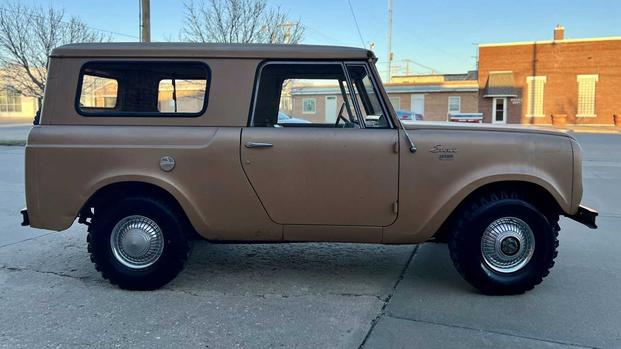
Bring A Trailer
In a move that could only have happened in the yesteryear of automobile production, International built its next iteration of the Scout in 1965 by announcing the updated Scout 800, and then proceeded to build the original Scout 80, branded as an 800, with the spare parts it had left over from the 80. The first true Scout 800 would launch in 1966, with a more comfortable interior and better road manners. The Scout 800 would also feature more muscle with a range of engines. Starting at a 196ci (3.2L) inline-four, buyers could upgrade to a 232ci (3.8L) inline-six, and later even a 266ci (4.4L) and 304ci (5.0L) V8 - a far cry from the small four-cylinder of its predecessor.
The 800A arrived in November of 1968, being an update to the beloved 800 series. It gained a different grille, improved soundproofing, new front-end styling, a larger rear axle and quieter Dana 20 transfer case. Again, like the 800 before it, the 800A was meant to be easier to live with and more suitable for the leisure pursuit buyer. The 800A was also the basis for the very popular trend of special trim editions. There was the Sportop package with a modified roofline, the now-coveted SR-2 edition with soft-top roof, white and gold paint and V8 engine, and lastly the crassly named Aristocrat package. This saw the car painted blue and silver, with a blue interior and even a chrome roof rack. It was the run-out model for the 800A.
The last variant of the 800 was named the 800B. It only lasted eight months, from August 1970 to March 1971, acting as a stop-gap while International prepared for the 800's true replacement. Other than more chrome, the 800B showed no other significant changes, but was again marketed with weird and wonderful trim packages. The first was the Comanche package - a blinged-up 800B with chrome, roof racks and plusher interior. Secondly, was the Sno-Star, which aimed at commercial buyers looking for a small, snowplow-compatible four-wheel-drive vehicle.
The International Scout II
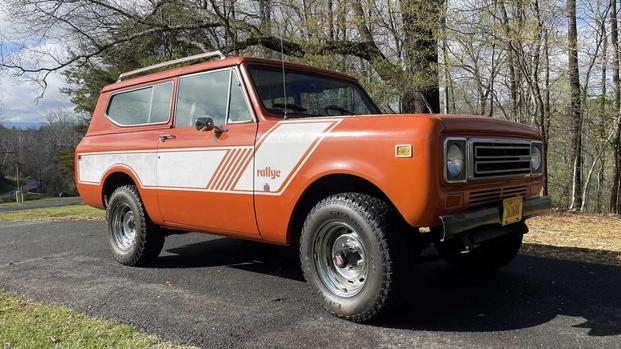
Bring A Trailer
The Scout II lasted till the end of International's journey in passenger vehicles, from 1971 till 1980. It was bigger, more powerful and overall more substantial than its earlier Scout 80 and 800 brethren, and for good reason. The Scout was no longer just a rival to the plucky Jeep CJ. The two-door body-on-frame SUV market had expanded greatly, with the Ford Bronco, Chevrolet Blazer, and Dodge Ramcharger all vying to become the next big off-road hit. The range of engines offered throughout its lifetime varied massively, coming in both gas and diesel configurations. All Scout IIs had a gross vehicle weight of 6,200 lb (2,800 kg) no matter the configuration to skirt around emissions regulations.
Engines offered in the Scout II
- 196 cu in (3.2L) IH I4
- 232 cu in (3.8L) AMC I6
- 258 cu in (4.2L) AMC I6
- 304 cu in (5.0L) IH V8
- 345 cu in (5.7L) IH V8
- 198 cu in (3.2L) Nissan SD33 I6 (1976-1979)
- 198 cu in (3.2L) Nissan SD33T turbo I6 (1979-1980)
The Scout II then came in either a Traveltop (full roof) or Cab Top (half cab) body option and later got even more distinct body styles in the form of two extended wheelbase versions. The Scout II Travelerextended the wheelbase of the regular Scout II an extra 18 inches, and came with its own roof and tailgate design, and even its own rear bench seating.
The Traveler was a more family focused model, meant for road trips, or a potential replacement for the Chevrolet Suburban. The interior was also upgraded with better materials to help sell this image of a family car from the industrial vehicle brand. The Scout Terra took that same extended 118-inch wheelbase but instead used it to give commercial pick-up buyers more bed space, with an elongated bed, removable roof and bulkhead, and focus on practicality and value.
The Scout II came in a myriad of special editions and trim levels, with International slapping on different paint and reupholstering the interior many times in a bid to keep it relevant in the market. By the 80s, International was done with its passenger car experiment, and pulled out of building light-duty trucks and SUVs entirely during a time of financial difficulty. It could be said it was smart to make this decision, as the writing was on the wall for body-on-frame, two-door SUVs in general. Both the Bronco and Blazer soldiered on - the Blazer lasting one more generation, and the Bronco lasting two. The Bronco's two generations were really more of a single generation with a facelift, with even the final 1996 models tracing their routes back to the 1980s model.
Read the full article on CarBuzz
This article originally appeared on CarBuzz and is republished here with permission.







